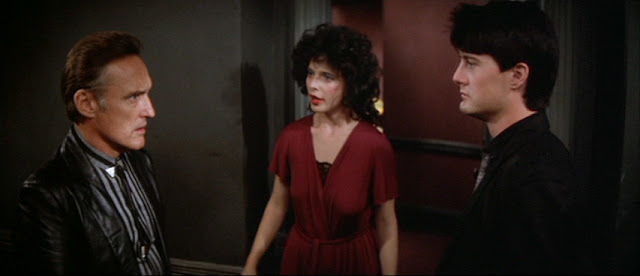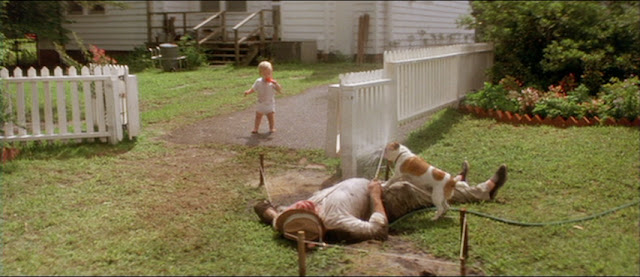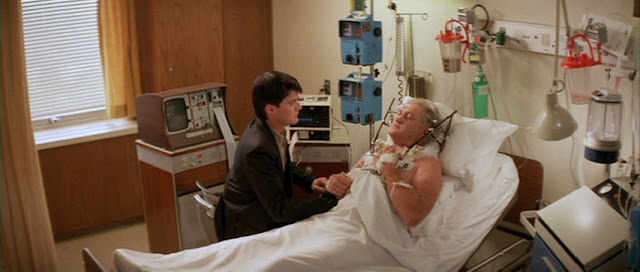The Score: 10 out of 10
David Lynch received the Academy Award nomination for Best Director three times in his career: The Elephant Man
 |
| Isabella Rossellini (Daughter of Ingrid Bergman) Receiving Direction from David Lynch on the Set of Blue Velvet |
After feeling like the dog wagged by his tail on Dune (1984), David Lynch took a step back to a simpler and less stressful form of film making on Blue Velvet (1986). Regrettably, Lynch would never again command the hundreds of cast and crew he once had available on Dune. The subtlety and nuance Lynch leant to that sprawling production is commonly overlooked and it is a shame he would never get a chance to paint with such rich colors again. But getting back to his more personal and experimental film-making roots was undeniably useful to Lynch, resulting in one of his most celebrated accomplishments.
A.O. Scott's RetrospectiveSiskel and Ebert's Review
David Lynch originally agreed to direct Dune (1984) under the proviso that Dino De Laurentis would produce a pet project of Lynch's choosing in the future. Although Dune underperformed at the box office, Dino looked forward to collaborating with the genius director again and inquired about a screenplay Lynch had been writing off and on since 1973, Blue Velvet. Unhappy with the last half of the story, Lynch sent the first half of the script for Dino's perusal. Dino loved it and commissioned Lynch to finish the screenplay and prepare for production.
 |
| David Lynch Receives the Greatest Honor a Hollywood Director Can Earn: Final Cut |
David Lynch "Canadian TV" Interview
Dino assuaged Lynch's fears, but explained if he included final cut in the contract, then every other director would demand the same from him in the future. But Dino did offer Lynch his word that for all intents and purposes, Lynch would have final cut on Blue Velvet (1986). Within certain reasonable constraints, Lynch would have final approval on all editing decisions, the lack of that power arguably dooming their previous collaboration together, Dune (1984). Dune went from being a sprawling three hour epic to a truncated 2 hour 15 minute compromise. The two men shook hands on it and Dino was a man of his word. |
| A Bizarre, Yet Realistic Mystery Shockingly Unfolds Before Your Eyes... |
 |
| Dennis Hopper's Contributions to the Film Helped Cement it as a Classic |
SHE WORE BLUE VELVET
 |
| Isabella Rossellini's Touching Portrayal of Dorothy Vallens A Desperate Woman Living in Constant Terror |
The Opening Sequence
Many people cite the opening of Blue Velvet (1986) as one of the most brilliant ever devised. David Lynch uses abstract images to set up the film's themes concisely before the main story begins. The barriers usually blinding us to the evils of the seamy criminal underworld are soon going to evaporate before our eyes. Jeffrey Beaumont discovers a severed human ear while visiting his father in the hospital one day. This strange event opens a doorway for him into the strange, destructive world of criminals who live not much more than a stone's throw away from his house.
Throughout the course of the film, we peer beneath the surface of civilized society and get a glimpse of dark and terrifying things. But unlike other filmmakers, Lynch has no intention of keeping us trapped down there entirely. A beautiful sense of innocence permeates Jeffrey's life, contrasting the shocking depravity he encounters while exploring the story behind the severed ear. In Blue Velvet, Lynch will bring us back and forth between two worlds, one light, one dark. And as the Jeffrey progresses on his journey, we grow concerned about which world he will ultimately inhabit.
Without revealing too many twists of the story, Jeffrey brings the ear to the police. The police will not explain any details of the case since the ear relates to an ongoing investigation. The police detective's eavesdropping daughter Sandy is not satisfied with this dead end either. Sandy and Jeffrey team up to investigate the case on their own, but they soon get in over their head as they encounter Frank Booth and Dorothy Vallens, played to perfection by Dennis Hopper and Isabella Rossellini.
Lounge Singing Scene
 |
| Heath Ledger's Joker in The Dark Knight (2008) Seems Influenced by Hopper's Frank Booth in Blue Velvet (1986) |
 |
| Frank Booth Smears Lipstick All Over His Lips and Sticks a Knife Next to Jeffrey's Face While Carrying on a Bizarre, Protracted Conversation with the Terrified Young Man |
Sandy dreamed of Jeffrey and of a world filled with darkness and devoid of happiness by an absence of robins. But Sandy lights up with an infectious hope as she describes the return of the robins in her dream. In a scene that could have been cheesy and distracting in the middle of a far darker story, Lynch instead brings a synergy to this simple conversation to make it far weightier than it could have been otherwise. Their interactions are sweet and deliberately silly with the earnest affection they develop. The clip below is of a scene later in the film where their delicate fledgling romance blossoms.
The Mysteries of Love
This scene summarizes the impact of Blue Velvet (1986). The film could have devolved into a saccharin mess on one end, or an overpoweringly dark and bleak tale on the other. In any other director's hands it would have likely skewed in one direction or the other. But in the hands of David Lynch, the material transcends into an ethereal opus keeping the audience engaged and in suspense regardless of the number of times you watch the film. Alfred Hitchcock would be proud of Lynch's achievement.
Many people's first reaction to Blue Velvet is "I loved what I just saw, but I do not understand why." The film is greater than the sum of any of its parts. The story threads of the small town mystery, the simple love story, the dark thriller, and the threat of Jeffrey losing his soul blend together and transcends into a timeless masterpiece for the modern age.
THE MAKING OF BLUE VELVET
 |
| David Lynch Continues His Rewarding Collaboration with Kyle MacLachlan From Dune (1984) to Twin Peaks: Fire Walk with Me (1992) |
 |
| On the Right: Jack Nance Plays One of Frank Booth's Hapless Toadies |
 |
| David Lynch Admiring an Artificial Frank Booth Before Shooting a Complex Special Effect |
 |
| David Lynch and Isabella Rossellini Fell in Love and Were Engaged Four Years |
But this type of slander created a haze of ambiguity and doubt in the minds of mainstream audiences, preventing many from watching an amazing film. In spite of these obstacles, the film still performed well at the box office, easily earning back its budget and earning a healthy profit. Blue Velvet (1986) helped reinvigorate the career of David Lynch, again making him viable commercially.

David Lynch often portrays abused female characters with empathy and understanding, like he would go on to do in his most famous mainstream production, the Twin Peaks TV series. Dorothy Vallens in Blue Velvet would later usher his ultimate woman of mystery: Laura Palmer. In many ways, Twin Peaks (1990-91) would echo the themes, images, and tone of Blue Velvet (1986) from the big screen to the small screen and to the big again with the underrated Twin Peaks prequel feature film Fire Walk with Me (1992).
At the end of Blue Velvet, Jeffrey Beaumont escapes the nightmarish underworld he plunged into and arrives back into the world of light. Happiness and love now fill his life, ending the film on a bright note. In what feels like an homage to the animatronic robins of Walt Disney's Mary Poppins
Blue Velvet
Blue Velvet (1986) Theatrical Trailer
| Blue Velvet U.S. Blu-Ray Release: Nov. 08, 2011 |
Wild at Heart (1990) Theatrical Trailer
In 1990 Wild at Heart won the Palme d'Or, the top honor at the Cannes Film Festival. Many consider it David Lynch's most random and bizarre film, filled with more extreme violence, gratuitous nudity, and sexuality than in most his other work. Most fans of David Lynch seem to rank this film near the bottom of their list of Lynch's films. But Lynch maintains an oddly comedic tone to this bleak and horrific road movie and his mastery of raw cinematic power is clear from the opening scene to its bizarrely beautiful ending.Sailor Confides to Lula
The film follows two lovebirds on an absurd road trip through America's heartland, played by Nicolas Cage and Laura Dern. Dern's real-life mother Dianne Ladd plays her evil mother in the film, a figurative and literal wicked witch. The motifs and themes of The Wizard of OzPrevious Article
DUNE (1984)
Next Article
WILD AT HEART (1990)
Note: Any purchase made via our web store or the product links scattered throughout the article contribute a small portion to the running of this site. Thank you for your support.






















































Nice analysis! But I think you miss one or, at least, you should notice it. The "squeezing hosepipe" is a perfect representation of heart attack. As spectator, you can pratically feel it. Its brillant!
ReplyDeleteOtherwise, maybe you can help me to undertand something in one of the movie's scene. In Jeffey's bedroom, there is an object fixed on the wall next to his bed. What is that? What's its meaning?
You are right about how the sequence of images showing the hose getting constricted helped create a tangible feeling of the heart attack (or stroke) that Jeffrey's father suffered. Lynch can help you feel this event rather than just observe it.
ReplyDeleteThe object hanging above Jeffrey's bed is a small bird house, likely something Jeffrey made as a boy. Since the film is not available on Blu-Ray yet in the U.S., we have to rely on a blurred view of it on the DVD.
This birdhouse is evidence that Jeffrey's parents kept his room just the way he left it when he left to college, anticipating his future visits. Many modern parents would probably convert their son's room into something more useful to them, but Jeffrey's parents are from a more classical American tradition. Jeffrey is the most important thing in their lives. They keep his room the same as he left it.
It probably pleased Lynch to have Jeffrey reach out to a symbol of his childhood innocence hanging over him, a desperate desire to return from the darkness he has entered. He longs for simpler times, before his recent loss of innocence.
Also, shortly before this scene where Jeffrey reaches up to the birdhouse, Sandy had discussed her dream of the return of the robins. She explained that in her dream the world was filled with trouble and darkness, but only love--as represented by the robins--could dispel the darkness in the world. Jeffrey is literally reaching for a safety net, looking for the robin in his childhood birdhouse.
You also see the birdhouse hang over Jeffrey in a later sequence in the film as he cries over the horrible and abusive things done to Dorothy Vallens, including things he himself did to her. David Lynch communicates with visual metaphors, showing how reminders of Jeffrey's simpler life have helped him come full circle. Jeffrey wants to abandon the dark path he has set out on and return to the virtuous life he left behind.
Im very scpetical. I still cannot see the birdhouse. According to me, it looks like a rock with some paintings. I can see a kind a of monster's mouth with tongue and teeth. I ever tought Lynch introduce that thing as a surrealistic element, like the doll on the couch at Ben's. But, you seem pretty sure of you and your explanation make some sense. Besides, where did you get your info about Jeffrey's parents and their will to keep his room in a certain way? Is it a deduction or I miss something?
ReplyDeleteKeep the good work
Just finished watching the film again and came across this, thanks!
ReplyDeleteRe: Ebert and his nonsense opinion about Rosellini's character....he totally overlooked part of the point that Lynch was making with Dorothy and her psychology...
ReplyDelete...that there was actually a part of her that actually enjoyed the abuse...on some level!!!
Whether we like this or not 'personally'...is totally irrelevant...and this point was entirely missed and lost on him.
Am loving your blog...superb work.
I always thought the item hanging over the bed in the scene you guys mention is a dreamcatcher. I think this explains why after Jeffrey wakes up from his nightmare he looks up at it. No one would have a painted rock or birdhouse hanging on their bedroom wall...lol
ReplyDeleteI arrived to this page because of the hanging thing on Jeffrey's bedroom and it does not look like a birdhouse at all to me. It is definitely a 'monsterish' thing. I'm with AnonymousDecember 6, 2010. To me it looks like a mouth.
ReplyDeleteIt was a Madball - I had one just like that when I was a child - a squeezeable ball of rubber that you can fill with water.
ReplyDelete